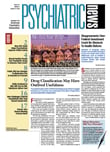Having a purpose in life and possessing a sense of mastery over life events appear to be associated with resilience and the ability to “bounce back” after a traumatic experience.
But assaultive traumas—such as being raped, beaten, or kicked—and a higher exposure to multiple traumatic events appear to render an individual less resilient than he or she might otherwise be.
Those were two findings from a unique study looking at psychosocial factors associated with resilience and recovery in a high-risk sample of African Americans in a primary care setting. The report appears in the December 2008 American Journal of Psychiatry.
Lead investigators Tanya Alim, M.D., and Adriana Feder, M.D., told Psychiatric News that the cross-sectional study does not establish a causal relationship between psychosocial factors and resilience, but lays the groundwork for a longitudinal study looking at strategies to prevent traumatic reactions or increase resilience for people who have suffered trauma.
“It may be that having a higher purpose in life is protective [against the effects trauma], or it may be that for people who experience trauma regaining a sense of purpose is conducive to recovery,” Feder said in an interview.
Also associated with resilience was a higher frequency of attendance at religious services, optimism, and a sense of mastery, the researchers found.
“Most of what we know about traumatized individuals come from treatment studies,” Feder added. “What is unique about this study is that it focused on a general medical population with low rates of psychiatric treatment, a setting in which we were more likely to find resilience.”
Alim added that the findings may be especially important for clinicians working in primary care settings, where African Americans are more likely to seek treatment for trauma. “A lot of these factors are going to be picked up in the primary care setting,” she said.
Alim is an assistant professor of psychiatry and behavioral sciences and director of the mental health clinic at Howard University. Feder is an assistant professor of psychiatry at Mt. Sinai School of Medicine in New York.
In the study, researchers evaluated patients for past traumatic experiences at four primary care offices at Howard University in Washington, D.C. All patients who identified at least one significant traumatic event meeting criterion A1 for PTSD in DSM-IV were invited to participate in a face-to-face assessment of lifetime psychiatric disorders.
After exclusion of patients with bipolar or psychotic disorders, the final sample had 259 patients. These were divided into three groups: 47 patients who had never experienced psychiatric disorder (defined as the“ resilient” group); 85 patients who had recovered from at least one disorder and did not currently have a psychiatric disorder; and 127 patients who had a psychiatric disorder.
Posttraumatic stress disorder was the most common past disorder for the recovered group and the most common current diagnosis for the currently ill group. But substance abuse disorders—including alcohol abuse, alcohol dependence, substance abuse, and substance dependence—were more common in the past of recovered patients.
Being female was predictive of being in the currently ill group: of the 127 in the currently ill group, 95 were women. There was a significantly lower lifetime trauma “load”—the number and frequency of traumas experienced over a lifetime—among those in the resilient group. Assaultive traumas, including being physically or sexually assaulted, assaulted with a weapon, or held in captivity, were more common among both the recovered and currently ill groups.
Interestingly, trauma load did not significantly differ between the recovered and currently ill groups, suggesting that other factors are important in recovery.
Also of note is the fact that the only factor that possibly differentiated the resilient from the recovered group was higher posttraumatic“ growth,” with higher growth being reported in the recovered group.
“A person might say, 'After I was assaulted, I actually got closer to people, and I realized I was strong,'” Feder said. “Psychological growth after trauma was marginally more predictive of recovery, suggesting that people in that group had to struggle [to achieve recovery].”
The absence of other significant differences in psychological factors associated with resilient or recovered status suggests that some of the same mechanisms that protect individuals from developing psychiatric disorders are likely also involved in recovery, the researchers stated.
In an editorial accompanying the report, American Journal of Psychiatry Editor in Chief Robert Freedman, M.D., noted the importance of the findings for understanding possible preventive strategies. “Sadly, physical assault seems to crush the ability of women to achieve purpose and mastery,” he wrote. “However, the African-American women in the study who showed resilience seemed to benefit from increased attendance at religious services, which has traditionally been a strong social support for many groups. Optimism and emotional expression also supported resilience.
“Many of these coping factors were positively correlated and may be an expression of a single underlying character strength.”
Feder and Alim and colleagues concluded, “It is our hope that further research on psychological factors identified by this and other studies will ultimately lead to the development of new types of preventive and treatment interventions. Further studies need to identify which psychosocial factors are consistently associated with resilience and determine to what extent these factors may be modifiable through clinical intervention.”

